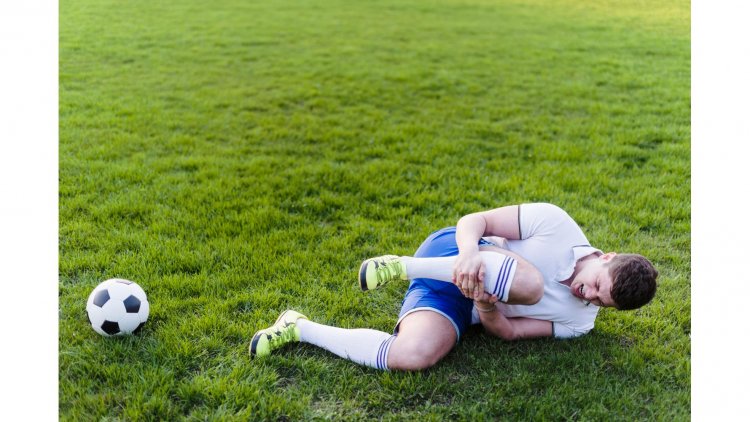Safeguard Your Game: Expert Tips to Avoid Sports Injuries
Sports injuries can sideline even the most dedicated athletes, but with the right strategies, you can significantly reduce your risk and keep performing at your best. Whether you’re a professional athlete or a weekend warrior, understanding how to prevent injuries is crucial. This comprehensive guide brings you expert tips and advice on how to stay in the game without falling victim to common sports-related injuries.

Understanding the Basics of Injury Prevention
Preventing injuries starts with understanding the basic principles of physical health and conditioning. By adhering to some foundational strategies, you can lay a solid groundwork for injury prevention.
- Prioritize Proper Warm-Ups and Cool-Downs
Warming up and cooling down are not just routine tasks; they play a crucial role in preparing your body for intense activity and aiding in recovery afterward. A proper warm-up increases blood flow to your muscles, enhances flexibility, and prepares your cardiovascular system for the demands of exercise. It also helps reduce muscle stiffness, which can be a precursor to injury.
Warm-Up Guidelines:
- Dynamic Stretching: Engage in dynamic stretches such as leg swings, arm circles, and torso twists to activate the muscles you'll use.
- Gradual Increase in Intensity: Start with low-intensity activities like jogging or jumping jacks, gradually increasing the intensity to match the demands of your sport.
Cooling down, on the other hand, helps return your heart rate to normal and prevents muscle stiffness. It also aids in the removal of metabolic waste products produced during exercise.
Cool-Down Guidelines:
- Static Stretching: Incorporate static stretches that focus on the major muscle groups you worked. Hold each stretch for 15-30 seconds.
- Deep Breathing: Practice deep breathing techniques to promote relaxation and reduce muscle tension.
- Emphasize Strength and Flexibility Training
A strong and flexible body is less prone to injury. Strength training helps build the muscles, tendons, and ligaments necessary for supporting your joints. Flexibility exercises, meanwhile, improve your range of motion and can prevent strains and sprains.
Strength Training Tips:
- Focus on Key Muscle Groups: Strengthen not just the primary muscles used in your sport, but also the supporting muscles that help stabilize your joints.
- Use Proper Form: Always use correct technique to avoid unnecessary stress on your body and reduce the risk of injury.
Flexibility Training Tips:
- Incorporate Yoga or Stretching Routines: Regular yoga or stretching routines can improve overall flexibility and balance.
- Stretch Consistently: Make stretching a regular part of your training regimen, not just a pre- or post-workout activity.
- Practice Sport-Specific Techniques
Different sports have different demands and risks. Understanding and practicing the specific techniques required for your sport can greatly reduce your risk of injury.
Technique Tips:
- Learn Proper Form: Work with a coach or trainer to ensure you’re using the correct form for your sport. This applies to everything from running gait to tackling techniques in contact sports.
- Gradual Progression: Increase the intensity and duration of your training gradually to allow your body to adapt and strengthen over time.
Injury Prevention Through Proper Equipment and Gear
Using appropriate sports equipment and gear can make a significant difference in injury prevention. Equipment not only provides protection but also enhances performance and comfort.
- Invest in Quality Footwear
Footwear plays a critical role in injury prevention, especially in sports that involve running or jumping. Good shoes can provide the necessary support, cushioning, and traction to prevent injuries.
Footwear Tips:
- Choose Sport-Specific Shoes: Select shoes designed for your particular sport, whether it’s running shoes with extra cushioning or cleats for soccer.
- Replace Worn-Out Shoes: Regularly check the condition of your shoes and replace them as needed to maintain optimal support.
- Use Protective Gear
Depending on the sport, different types of protective gear might be necessary to safeguard against injuries. This includes items such as helmets, pads, and braces.
Protective Gear Tips:
- Wear Appropriate Gear: Use gear that’s specifically designed for your sport, such as mouthguards for contact sports or shin guards for soccer.
- Ensure Proper Fit: Protective gear should fit properly to provide effective protection. Gear that’s too loose or too tight can be counterproductive.
- Maintain Equipment
Regular maintenance of your sports equipment can prevent injuries caused by faulty or worn-out gear.
Equipment Maintenance Tips:
- Inspect Regularly: Check your equipment for any signs of damage or wear before each use.
- Follow Manufacturer’s Instructions: Adhere to any care and maintenance guidelines provided by the equipment manufacturer.
Building a Strong Foundation with Nutrition and Hydration
Proper nutrition and hydration are often overlooked aspects of injury prevention, yet they are vital for maintaining overall health and performance.
- Fuel Your Body with Balanced Nutrition
Eating a balanced diet provides your body with the essential nutrients needed for energy, muscle repair, and overall health. A well-nourished body is better equipped to handle the physical demands of sports.
Nutrition Tips:
- Include a Variety of Foods: Eat a mix of proteins, carbohydrates, fats, vitamins, and minerals to support different aspects of your health.
- Prioritize Protein: Protein is crucial for muscle repair and recovery, so ensure you’re getting enough from sources like lean meats, dairy, or plant-based proteins.
- Stay Hydrated
Dehydration can impair your performance and increase the risk of cramps and injuries. Proper hydration helps regulate body temperature and maintain joint lubrication.
Hydration Tips:
- Drink Water Regularly: Aim to drink water throughout the day, not just during exercise.
- Monitor Hydration Status: Pay attention to signs of dehydration, such as dark urine or excessive thirst, and adjust your fluid intake accordingly.
- Consider Supplements Wisely
While a balanced diet should meet most of your nutritional needs, some athletes may benefit from supplements. Consult with a healthcare professional before starting any new supplement regimen.
Supplement Tips:
- Focus on Key Supplements: Common supplements like omega-3 fatty acids, vitamin D, and calcium can support joint health and overall performance.
- Avoid Over-Reliance: Supplements should complement a healthy diet, not replace it.
Embrace Rest and Recovery
Rest and recovery are critical components of any training program. Overtraining can lead to burnout and increase the risk of injuries.
- Prioritize Quality Sleep
Adequate sleep is essential for muscle recovery and overall well-being. Aim for 7-9 hours of quality sleep per night to support your athletic performance.
Sleep Tips:
- Establish a Routine: Go to bed and wake up at the same time each day to regulate your sleep cycle.
- Create a Restful Environment: Ensure your sleep environment is comfortable, dark, and quiet to promote restful sleep.
- Schedule Rest Days
Rest days are just as important as training days. They give your body time to recover and adapt to the stresses of exercise.
Rest Day Tips:
- Incorporate Active Recovery: Light activities like walking or gentle stretching can aid in recovery without putting additional strain on your body.
- Listen to Your Body: Pay attention to signs of fatigue or soreness and adjust your rest days accordingly.
- Manage Stress
Chronic stress can negatively impact your physical health and increase your risk of injury. Implement stress management techniques to maintain overall well-being.
Stress Management Tips:
- Practice Relaxation Techniques: Engage in activities such as deep breathing, meditation, or mindfulness to reduce stress.
- Maintain a Balanced Lifestyle: Balance training with other aspects of life to prevent burnout and maintain mental health.
Elevate Your Game: Advanced Strategies for Injury Prevention
Continuing from where we left off, let’s delve into more specialized strategies and expert advice to further enhance your injury prevention practices. These advanced techniques and considerations can offer additional layers of protection and optimization for your athletic endeavors.
Incorporate Injury Prevention Protocols
Incorporating systematic injury prevention protocols into your training routine can proactively address potential risk factors and enhance your overall safety.
- Implement a Periodization Plan
Periodization involves dividing your training year into different phases, each with specific goals and intensity levels. This structured approach helps to prevent overtraining and reduces the risk of injuries associated with excessive stress.
Periodization Tips:
- Plan Phases: Divide your training into macrocycles (yearly), mesocycles (monthly), and microcycles (weekly) with varying intensity and focus.
- Include Recovery Phases: Ensure each cycle includes periods of lower intensity or rest to allow your body to recover.
- Utilize Injury Prevention Exercises
Certain exercises specifically target injury prevention by strengthening muscles, enhancing stability, and improving joint function.
Injury Prevention Exercises:
- Core Strengthening: Exercises like planks and Russian twists enhance core stability, which is crucial for overall balance and injury prevention.
- Balance Training: Activities such as single-leg stands or stability ball exercises improve proprioception and reduce the risk of falls and joint injuries.
- Monitor and Adjust Training Loads
Managing your training load is critical to preventing injuries. This involves balancing training intensity, volume, and frequency to avoid overuse injuries.
Training Load Tips:
- Use Technology: Employ tools like heart rate monitors or GPS trackers to monitor training intensity and volume.
- Gradual Progression: Increase training loads incrementally and avoid sudden spikes in intensity or volume.
Engage in Sport-Specific Injury Prevention
Different sports come with unique injury risks and prevention needs. Tailoring your injury prevention strategies to your specific sport can greatly enhance effectiveness.
- Custom Tailored Warm-Ups
Sport-specific warm-ups are designed to mimic the movements and demands of your sport, preparing your body for the unique stresses it will face.
Warm-Up Customization Tips:
- Incorporate Sport-Specific Movements: Include drills and exercises that replicate the movements you’ll perform during your sport.
- Focus on Common Injuries: Address common injury risks specific to your sport in your warm-up routine.
- Address Common Sport-Specific Injuries
Different sports have different common injuries. Understanding these can help you implement more targeted prevention strategies.
Injury-Specific Strategies:
- Running Sports: Focus on strengthening the knees and hips to prevent runner’s knee and IT band syndrome.
- Contact Sports: Use proper tackling techniques and protective gear to reduce the risk of concussions and joint injuries.
- Work with a Sports Specialist
Consulting with a sports-specific specialist, such as a physiotherapist or sports medicine doctor, can provide personalized injury prevention strategies and advice.
Specialist Consultation Tips:
- Seek Expertise: Find professionals who specialize in your sport or type of injury for the most relevant advice.
- Follow Recommended Protocols: Adhere to any recommended exercises, techniques, or preventative measures provided by specialists.
Focus on Mental Conditioning for Injury Prevention
Mental conditioning plays a vital role in injury prevention. Psychological preparedness and resilience can help you maintain focus and manage stress, which can impact physical health.
- Develop a Strong Mental Game
Building mental toughness can improve your ability to handle the physical and psychological demands of sports, which indirectly contributes to injury prevention.
Mental Game Tips:
- Visualization Techniques: Use visualization to mentally rehearse your performance and anticipate potential challenges.
- Stress Management: Employ techniques such as meditation or cognitive behavioral strategies to manage stress and anxiety.
- Create a Supportive Environment
Having a supportive network can positively impact your mental and physical well-being, reducing the risk of injuries related to stress or burnout.
Supportive Environment Tips:
- Build a Team: Surround yourself with coaches, teammates, and family who support your goals and well-being.
- Seek Professional Help: Consider working with a sports psychologist to develop coping strategies and enhance mental resilience.
Monitor and Adapt to Your Body’s Signals
Listening to your body and adapting your training based on its signals is crucial for preventing injuries. Being attuned to your physical and psychological state can help you catch potential issues before they escalate.
- Recognize Early Warning Signs
Identifying early warning signs of injury can help you take preventative action before a minor issue becomes a major problem.
Warning Signs Tips:
- Pay Attention to Pain: Differentiating between normal exercise soreness and pain that could indicate an injury is important. Seek medical advice if pain persists.
- Monitor Fatigue Levels: Persistent fatigue or decreased performance can be indicators of overtraining or developing injuries.
- Adjust Training Based on Feedback
Adjusting your training based on how your body responds can help prevent injuries and ensure you’re training optimally.
Adjustment Tips:
- Modify Workouts: If you experience discomfort or signs of potential injury, modify your workouts to reduce intensity or change exercises.
- Prioritize Rest: Incorporate additional rest or recovery days if needed, based on your body’s feedback.
Embrace Technological Advancements in Injury Prevention
The integration of technology into training and injury prevention is becoming increasingly common. Utilizing these advancements can provide additional support and insights.
- Wearable Technology
Wearable devices can monitor various physiological parameters and provide valuable data to help manage training loads and detect potential issues.
Wearable Tech Tips:
- Track Metrics: Use devices to monitor metrics such as heart rate, sleep patterns, and physical activity levels.
- Analyze Data: Review the data to make informed decisions about training intensity and recovery needs.
- Injury Prevention Apps
There are several apps designed to assist with injury prevention by providing exercises, monitoring progress, and offering personalized recommendations.
App Tips:
- Choose Reputable Apps: Select apps that are developed by reputable sources and have positive reviews from users.
- Utilize Features: Take advantage of features such as exercise libraries, progress tracking, and injury prevention tips.
Final Thoughts
Incorporating these expert tips and advanced strategies into your routine can significantly enhance your ability to prevent sports injuries. By focusing on proper preparation, using the right equipment, maintaining optimal nutrition and hydration, and paying attention to your body’s signals, you can improve your overall performance and safety in sports. Embracing these practices not only helps in avoiding injuries but also in achieving peak performance, ensuring that you stay in the game for the long haul.
Disclaimer: The information provided in this article is for educational purposes only and should not be considered medical advice. If you have any health concerns or are experiencing symptoms, it is important to consult with a healthcare professional, such as a doctor or clinic, for proper diagnosis and treatment. Always seek the advice of your doctor or other qualified health provider with any questions you may have regarding a medical condition. Do not disregard professional medical advice or delay in seeking it because of something you have read in this article.
What's Your Reaction?





















